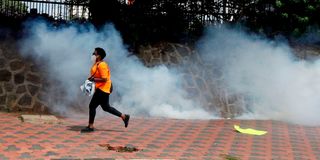When march against death met violence on Human Rights Day

A woman flees teargas in downtown Nairobi after police dispersed peaceful anti-femicide protesters during the nationwide 'End Femicide Kenya' march demanding stricter government action, on December 10, 2024.
What you need to know:
- Women-led initiatives like Sigand Nyinam highlight unity and sustainable solutions to gender-based violence.
- Peaceful anti-femicide protesters in Nairobi faced teargas, sparking outrage over police brutality.
As I write this, my eyes still sting – not from the teargas that was lobbed at peaceful anti-femicide protesters in Nairobi's streets this Tuesday, but from the tears of frustration and anger that refuse to stop flowing. On International Human Rights Day, no less, we witnessed our police force-respond to women's calls for safety with violence.
The irony is haunting. As we marked the end of the 16 Days of Activism Against Gender-Based Violence (GBV), hundreds of women gathered to protest the alarming spike in femicides in our country. Their weapons? Placards and whistles. Their crime? Demanding that our daughters, sisters, mothers and aunts stop dying.
Peaceful assembly
The statistics behind their protest are chilling. Between August and October alone, 97 women were killed in gender-motivated attacks. That's more than one woman per day. Compare this to 75 such killings in 2022 and 46 in 2021. The trend is clear – and terrifying. Yet when we gathered to peacefully protest against this epidemic of violence, we were met with teargas and arrests. Even Irũngũ Houghton, Amnesty International Kenya's Executive Director and a steadfast ally in the fight against GBV, wasn't spared – in a country whose Constitution explicitly protects the right to peaceful assembly and demonstration under Article 37.
But even as teargas clouded Nairobi's streets, I found hope in a different Kenya. Just days before this shameful display, I witnessed the power of unity at the Sigand Nyinam (Daughters of the Lake) convention in Migori County. Women politicians, academics, corporate leaders, and grassroots activists from four Luo Nyanza counties came together with a shared purpose: to tackle what they call the "triple threat" – GBV, teenage pregnancies, and new HIV infections. The statistics they shared were equally sobering: 26,929 adolescent pregnancies in their four counties alone last year, with more than 80 adolescents seeking maternal services daily.
This stark contrast makes me think about the cruel mathematics of it all. Our government spends taxpayers' money on teargas to disperse women protesting against being killed, while GBV costs Kenya Sh46 billion annually – about 1.1 per cent of our GDP. Each survivor spends an average of Sh16,464 on medical care. Add to this the Sh25 billion spent yearly on antiretroviral drugs, and the picture becomes clear: violence against women isn't just destroying lives; it's crippling our economy.
Safe spaces
Other countries show us the better way forward. In Argentina, for example, mass protests against femicide led to the creation of a national registry of femicides and comprehensive legislation. The country understood that when women march, they're not threatening public order – they're fighting for their lives.
The peaceful marches in other towns, including Nyeri, Kilifi, Nakuru, and Kisii, among others demonstrated what could have been possible in Nairobi. In Nyeri, police escorted protesters to the deputy county commissioner's office. That's what support looks like. That's what protection looks like. What message are we sending when Nairobi responds to the same peaceful protests with violence? To the families of victims, to the women living in fear, to the next generation watching how we handle this crisis?
Initiatives like Sigand Nyinam show us that our fight extends beyond these 16 Days of Activism. When women come together – whether in convention halls or city streets – they create enduring spaces for change. The Daughters of the Lake's pledge to combat violence against women, support survivors, and create safe spaces for honest conversations about gender equality offers a blueprint for sustained action. Imagine if every region had such a platform for collective action and support.
While this year's 16 Days of Activism ended with tears and teargas, our fight continues. As a gender editor, I remain committed to telling these stories – of both our struggles and our triumphs. We will not be silenced. Not by teargas, not by arrests, not by fear. Because every time we gather – whether in protest or in celebration of our resilience – we do so for those who no longer can.
These women you dispersed are not your enemy. They are your mothers, sisters, daughters, and wives. They are Kenyans exercising their constitutional rights to demand something fundamentally human – the right to live without fear. The next time women gather to protest against being killed, don't ask why they're protesting. Ask yourself why we still need to.





